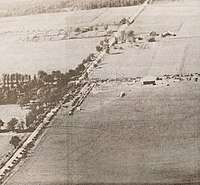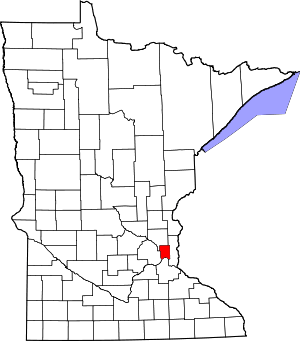Falcon Heights, Minnesota
Falcon Heights is a suburb of Saint Paul and a city in Ramsey County, Minnesota, United States. The population was 5,321 at the 2010 census.[6] It became a village in 1949 and a city in 1973.[7]
Falcon Heights | |
|---|---|
| Motto(s): "Families, Fields and Fair" | |
 Location of the city of Falcon Heights within Ramsey County, Minnesota | |
.png) Falcon Heights on The National Map | |
| Coordinates: 44°59′17″N 93°10′28″W | |
| Country | United States |
| State | Minnesota |
| County | Ramsey |
| Area | |
| • Total | 2.24 sq mi (5.80 km2) |
| • Land | 2.23 sq mi (5.78 km2) |
| • Water | 0.01 sq mi (0.02 km2) |
| Elevation | 955 ft (291 m) |
| Population | |
| • Total | 5,321 |
| • Estimate (2019)[3] | 5,528 |
| • Density | 2,475.59/sq mi (955.87/km2) |
| Time zone | UTC-6 (Central (CST)) |
| • Summer (DST) | UTC-5 (CDT) |
| ZIP codes | 55108, 55113 |
| Area code(s) | 651 612 (U of M campus only) |
| FIPS code | 27-20420[4] |
| GNIS feature ID | 0643548[5] |
| Website | www.falconheights.org |
Falcon Heights is the home of the University of Minnesota's St. Paul Campus and Les Bolstad Golf Course, the Minnesota State Fairgrounds, and the Gibbs Museum of Pioneer and Dakotah Life. Its University Grove neighborhood is known for its modern architecture.[8]
History
Heman Gibbs settled in the 1850s near the modern intersection of Cleveland and Larpenteur Avenues. His homestead is on the National Register of Historic Places and his home is a county museum.[7]
On September 2, 1901, then-Vice President Theodore Roosevelt first publicly used the African proverb "Speak softly and carry a big stick" in a speech at the Minnesota State Fairgrounds, which was still a part of St. Paul at the time. Roosevelt became president just two weeks later, upon the assassination of William McKinley, and built the phrase into his concept of Big Stick Diplomacy.[9]

Between the 1910s and 1930s, Curtiss Northwest Airport was located at the intersection of Snelling and Larpenteur Avenues. The airfield was important in Minnesota aviation history, hosting Charles Lindbergh, Speed Holman, and Phoebe Fairgrave.[10] Part of the land is now a city park named Curtiss Field.[7]
In the 1930s, a real estate agent named Faulkner developed land owned by a 3M executive and named this development—Falcon Heights—after himself. The first house arose in 1937.
In 1949 residents rejected annexation by Roseville or St. Paul, and voted to incorporate themselves.[11] The expanded Falcon Heights included the University of Minnesota Golf Course and Test Fields as well as the Minnesota State Fairgrounds. Two-thirds of Falcon Heights is public land, chiefly the university and state fair.[7]
Parks
Falcon Heights Community Park and Curtiss Field have recreational sports in the summer for kids and an ice rink and warming house in the winter. The community park also has a soccer field and a fitness course. Grove Park, in University Grove, also has a temporary warming house and ice rink in the winter.[12]
Geography
According to the United States Census Bureau, the city has a total area of 2.24 square miles (5.80 km2), of which 2.23 square miles (5.78 km2) is land and 0.01 square miles (0.03 km2) is water.[13]
Minnesota Highway 51 / Snelling Avenue serves as a main route in the community.
Falcon Heights is bordered by Lauderdale to the west, St. Paul to the south and Roseville to the north and east.
Demographics
| Historical population | |||
|---|---|---|---|
| Census | Pop. | %± | |
| 1950 | 3,884 | — | |
| 1960 | 5,927 | 52.6% | |
| 1970 | 5,530 | −6.7% | |
| 1980 | 5,291 | −4.3% | |
| 1990 | 5,380 | 1.7% | |
| 2000 | 5,572 | 3.6% | |
| 2010 | 5,321 | −4.5% | |
| Est. 2019 | 5,528 | [3] | 3.9% |
| U.S. Decennial Census | |||
.png)
2010 census
As of the census[2] of 2010, there were 5,321 people, 2,131 households, and 1,259 families living in the city. The population density was 2,386.1 inhabitants per square mile (921.3/km2). There were 2,254 housing units at an average density of 1,010.8 per square mile (390.3/km2). The racial makeup of the city was 73.3% White, 8.0% African American, 0.5% Native American, 15.0% Asian, 0.7% from other races, and 2.5% from two or more races. Hispanic or Latino of any race were 3.0% of the population.
There were 2,131 households, of which 26.8% had children under the age of 18 living with them, 48.7% were married couples living together, 7.6% had a female householder with no husband present, 2.7% had a male householder with no wife present, and 40.9% were non-families. 30.3% of all households were made up of individuals, and 10% had someone living alone who was 65 years of age or older. The average household size was 2.28 and the average family size was 2.91.
The median age in the city was 31.8 years. 19.4% of residents were under the age of 18; 16.8% were between the ages of 18 and 24; 29.7% were from 25 to 44; 21.8% were from 45 to 64; and 12.3% were 65 years of age or older. The gender makeup of the city was 46.9% male and 53.1% female.
2000 census
As of the census[4] of 2000, there were 5,572 people, 2,103 households, and 1,434 families living in the city. The population density was 2,487.9 people per square mile (960.4/km2). There were 2,136 housing units at an average density of 953.7 per square mile (368.2/km2). The racial makeup of the city was 77.66% White, 3.36% African American, 0.43% Native American, 14.95% Asian, 0.13% Pacific Islander, 1.33% from other races, and 2.15% from two or more races. Hispanic or Latino of any race were 3.09% of the population.
There were 2,103 households, out of which 32.6% had children under the age of 18 living with them, 58.9% were married couples living together, 7.2% had a female householder with no husband present, and 31.8% were non-families. 25.6% of all households were made up of individuals, and 8.8% had someone living alone who was 65 years of age or older. The average household size was 2.41 and the average family size was 2.91.
In the city, the population was spread out, with 21.5% under the age of 18, 17.0% from 18 to 24, 32.1% from 25 to 44, 17.3% from 45 to 64, and 12.2% who were 65 years of age or older. The median age was 31 years. For every 100 females, there were 92.7 males. For every 100 females age 18 and over, there were 88.7 males.
The median income for a household in the city was $51,382, and the median income for a family was $59,415. Males had a median income of $43,693 versus $34,757 for females. The per capita income for the city was $25,370. About 8.8% of families and 9.6% of the population were below the poverty line, including 13.4% of those under age 18 and 5.2% of those age 65 or over.
Education
Falcon Heights is served by the Roseville Area School District. Falcon Heights Elementary is the only school within the city boundary. The elementary school features a park with two playgrounds, one of them built in 2006.
In popular culture
The 2001 film Sugar & Spice was partly filmed in Falcon Heights.[14]
A small part of the 1996 film Jingle All the Way starring Arnold Schwarzenegger was filmed at Falcon Heights Elementary.[15]
References
- "2019 U.S. Gazetteer Files". United States Census Bureau. Retrieved July 26, 2020.
- "U.S. Census website". United States Census Bureau. Retrieved 2012-11-13.
- "Population and Housing Unit Estimates". United States Census Bureau. May 24, 2020. Retrieved May 27, 2020.
- "U.S. Census website". United States Census Bureau. Retrieved 2008-01-31.
- "US Board on Geographic Names". United States Geological Survey. 2007-10-25. Retrieved 2008-01-31.
- "2010 Census Redistricting Data (Public Law 94-171) Summary File". American FactFinder. U.S. Census Bureau, 2010 Census. Retrieved 23 April 2011.
- "History of Falcon Heights". City of Falcon Heights.
- Lee, Linda (January 5, 1989). "St. Paul's Architectural Time Capsule". The New York Times. Retrieved February 27, 2016.
- "Sept. 3, 1901: Roosevelt 'Big Stick' speech at State Fair".
- Bergerson, Roger (2008). Winging It at a Country Crossroads: The Ups and Downs of Minnesota's First Real Airport: Snelling & Larpenteur, Rose Township 1919-1930. ISBN 0615225497.
- Prather, Shannon (June 19, 2010). "Why do tiny cities like Lauderdale, Landfall and Falcon Heights exist?". Minneapolis Star Tribune. Retrieved June 19, 2010.
- "Parks and Shelters".
- "US Gazetteer files 2010". United States Census Bureau. Archived from the original on 2012-01-25. Retrieved 2012-11-13.
- "Sugar & Spice (2001)" – via www.imdb.com.
- "Jingle All the Way (1996)" – via www.imdb.com.
External links
| Wikimedia Commons has media related to Falcon Heights, Minnesota. |
